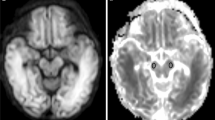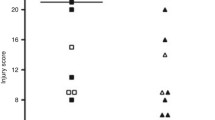Abstract
We hypothesized that the cerebral injury produced by hypoxia-ischemia (HI) in neonatal rats would differ in white compared with gray matter as detected histologically or with magnetic resonance (MR) imaging methods. Maps of T2 and the apparent diffusion coefficient (ADC) of water were acquired in 1-week-old rats at times prior to cerebral HI (right carotid artery occlusion plus 1.5 h of hypoxia), within the last 5–10 min of HI, and 1 h or 24 h after HI. Near the end of HI, ADC decreased and T2 increased in both cortical gray and subcortical white matter within the cingulum of the HI hemisphere. One hour after HI, ADC partially recovered, but T2 remained increased and then increased further by 24 h post-HI. In contrast to the similar MR responses in white and gray matter, histological evidence for irreversible cell damage occurred in white matter earlier than in gray matter within the HI hemisphere. At 1 h post-HI, rarefied or disrupted nerve fibers and an increase in TUNEL-positive cells were observed within white matter in the cingulum, whereas neurons within the cortical gray matter appeared normal. By 24 h post-HI, damage was apparent in both white and gray matter. Thus, MR imaging detected acute tissue edema following cerebral HI in both gray and white matter but did not distinguish between the early irreversible tissue injury detected histologically in white but not gray matter in this rather severe model of neonatal encephalopathy.



Similar content being viewed by others
References
Albensi BC, Schweizer MP, Rarick TM, Filloux F (1999) Unilateral hypoxic-ischemic injury in the neonatal rat brain evaluated by in vivo MRI. Correlation with histopathology and neuroprotection by MK-801. Invest Radiol 34:249–261
Barkovich AJ, Westmark K, Partridge C, Sola A, Ferriero DM (1995) Perinatal asphyxia: MR findings in the first 10 days. AJNR Am J Neuroradiol 16:427–438
Bozzao A, Di Paolo A, Mazzoleni C, Fasoli F, Simonetti A, Fantozzi LM, Floris R (2003) Diffusion-weighted MR imaging in the early diagnosis of periventricular leukomalacia. Eur Radiol 13:1571–1576
Counsell SJ, Allsop JM, Harrison MC, Larkman DJ, Kennea NL, Kapellou O, Cowan FM, Hajnal JV, Edwards AD, Rutherford MA (2003) Diffusion-weighted imaging of the brain in preterm infants with focal and diffuse white matter abnormality. Pediatrics 112:1–7
Derugin N, Wendland M, Muramatsu K, Roberts TP, Gregory G, Ferriero DM, Vexler ZS (2000) Evolution of brain injury after transient middle cerebral artery occlusion in neonatal rats. Stroke 31:1752–1761
Duong TQ, Ackerman JJ, Ying HS, Neil JJ (1998) Evaluation of extra- and intracellular apparent diffusion in normal and globally ischemic rat brain via 19F NMR. Magn Reson Med 40:1–13
Follett PL, Rosenberg PA, Volpe JJ, Jensen FE (2000) NBQX attenuates excitotoxic injury in developing white matter. J Neurosci 20:9235–9241
Hagberg H, Peebles D, Mallard C (2002) Models of white matter injury: comparison of infectious, hypoxic-ischemic, and excitotoxic insults. Ment Retard Dev Disabil Res Rev 8:30–38
Huppi PS (2002) Advances in postnatal neuroimaging: relevance to pathogenesis and treatment of brain injury. Clin Perinatol 29:827–856
Inder TE, Wells SJ, Mogridge NB, Spencer C, Volpe JJ (2003) Defining the nature of the cerebral abnormalities in the premature infant: a qualitative magnetic resonance imaging study. J Pediatr 143:171–179
Li F, Liu KF, Silva MD, Meng X, Gerriets T, Helmer KG, Fenstermacher JD, Sotak CH, Fisher M (2002) Acute postischemic renormalization of the apparent diffusion coefficient of water is not associated with reversal of astrocytic swelling and neuronal shrinkage in rats. AJNR Am J Neuroradiol 23:180–188
Manabat C, Han BH, Wendland M, Derugin N, Fox CK, Choi J, Holtzman DM, Ferriero DM, Vexler ZS (2003) Reperfusion differentially induces caspase-3 activation in ischemic core and penumbra after stroke in immature brain. Stroke 34:207–213
McQuillen PS, Ferriero DM (2004) Selective vulnerability in the developing central nervous system. Pediatr Neurol 30:227–235
Miyasaka N, Kuroiwa T, Zhao FY, Nagaoka T, Akimoto H, Yamada I, Kubota T, Aso T (2000) Cerebral ischemic hypoxia: discrepancy between apparent diffusion coefficients and histologic changes in rats. Radiology 215:199–204
Nedelcu J, Klein MA, Aguzzi A, Boesiger P, Martin E (1999) Biphasic edema after hypoxic-ischemic brain injury in neonatal rats reflects early neuronal and late glial damage. Pediatr Res 46:297–304
Qiao M, Malisza KL, Del Bigio MR, Tuor UI (2001) Correlation of cerebral hypoxic-ischemic T2 changes with tissue alterations in water content and protein extravasation. Stroke 32:958–963
Qiao M, Malisza KL, Del Bigio MR, Tuor UI (2002) Transient hypoxia-ischemia in rats: changes in diffusion-sensitive MR imaging findings, extracellular space, and Na+–K+-adenosine triphosphatase and cytochrome oxidase activity. Radiology 223:65–75
Rezaie P, Dean A (2002) Periventricular leukomalacia, inflammation and white matter lesions within the developing nervous system. Neuropathology 22:106–132
Sehy JV, Zhao L, Xu J, Rayala HJ, Ackerman JJ, Neil JJ (2004) Effects of physiologic challenge on the ADC of intracellular water in the Xenopus oocyte. Magn Reson Med 52:239–247
Towfighi J, Mauger D (1998) Temporal evolution of neuropathologic changes in immature rat model of cerebral hypoxia: a light microscope study. Dev Brain Res 109:169–177
Vannucci RC, Lyons DT, Vasta F (1988) Regional cerebral blood flow during hypoxia-ischemia in immature rats. Stroke 19:245–250
Volpe JJ (2003) Cerebral white matter injury of the premature infant-more common than you think. Pediatrics 112:176–180
Acknowledgements
This project was funded by the Robertson Fund for Cerebral Palsy. We thank Nicole Klementis, Lily Lin, and Milli Gupta for their excellent technical assistance.
Author information
Authors and Affiliations
Corresponding author
Rights and permissions
About this article
Cite this article
Meng, S., Qiao, M., Foniok, T. et al. White matter damage precedes that in gray matter despite similar magnetic resonance imaging changes following cerebral hypoxia-ischemia in neonatal rats. Exp Brain Res 166, 56–60 (2005). https://doi.org/10.1007/s00221-005-2340-8
Received:
Accepted:
Published:
Issue Date:
DOI: https://doi.org/10.1007/s00221-005-2340-8




